Welcome to our comprehensive guide to choosing a UX research repository that suits your organization’s needs. Grab a cup of tea, then dive into this treasure trove of priceless information and expert advice from research practitioners.
If you need evidence that research matters, look closely at the device you’re reading this on. Whether it’s Android, iOS or Windows (or Linux, we don’t discriminate), every detail of the user experience is likely steeped in research, and the titans of tech invest heavily in UX research each year.
Despite research’s growing importance, researchers today still grapple with age-old problems. User interviews take hours on end to tag properly and distill into key themes. New hires inherit a complex puzzle as they try to piece together fragmented findings across an organization. Without a central platform to elevate insights, user feedback and the value of research are drowned out for prospective audiences.
User research continues to be time- and resource-intensive. If only there were a solution to rid us of the dreaded drudgery of research…
Enter the UX research repository.
Summary of the UX Research Repository Landscape… (or just jump over here to read the state of research repositories industry report!)
- What is a research repository?
- Why you need a research repository
- How to organize a research repository
- Essential research repository features
- Choosing a research repository in 2023
- Benefits of a modern research repository tool
- Research repositories: Getting started


What is a Research Repository?
A research repository is a central archive for organizing and storing research, insights and user information. Think of a research repository as an encyclopedia, exclusively made up of a company’s findings — it brings all user research in one place so that you can easily conduct, analyze, organize and share customer insights across the organization.
A common misconception is that a research repository serves researchers exclusively. This couldn’t be farther from the truth — since research influences most departments within a company, a UX research repository acts as a knowledge bank for the entire organization.
So what type of knowledge goes into a research repository? The concept of ‘atomic research’ breaks it down into these four components:

At the end of the day, researchers provide a service for end users and key decision makers. Research repositories help you consolidate data, unearth patterns and trends across studies old and new, and facilitate informed business decisions.
What is the Difference Between a Database and a Repository?
A database is a structured collection of data organized into tables of rows and columns. Using a database management system, you can access, retrieve, update and query the data. Databases usually store data for a specific purpose, such as a CRM tool housing customer data. A database offers security and protection for confidential information.
A repository is a collection of elements, typically files and resources. It functions as a centralized warehouse to house a company’s knowledge. Repositories are used when data is complex, unstructured and non-relational. Researchers prefer a repository when their datasets are large and dynamic, making it easier for collaboration.
UX Research Repository Examples
Many universities, government-owned entities and other institutions make their research repositories available to the public.
There’s far too many to list here, but we’ll share a few examples:
Here’s a list of open repositories published by Springer Nature Group.
And here’s a research repository market map by our friends at Wonder.

Why You Need a UX Research Repository
Research seeks to identify customer needs, behaviors and goals to create better products and experiences for users. Repositories allow for easy mining and learning from insights, and bring efficiency to the research process. Let’s flip this around and see what industry professionals say happens when you don’t have a research repository in place:
Organizational Silos
Whether they know it or not, every department conducts different types of research, amassing various forms of data in the process. Calls, surveys, social media posts and informal conversations (to name a few) all reveal customer perspectives. Usually, knowledge within departments remains just that – within departments. Seldom communicated across the company, information becomes siloed and insights are lost before they see the light of day. Lou Rosenfeld, founder of Rosenfeld Media, cautions that organizational silos lead to an incomplete and unbalanced understanding of customers and inhibit new learnings. He uses the fable of the elephant and the blind men to illustrate the importance of consolidating different perspectives to see the bigger picture.
Knowledge and Insight Burial
Ever download a useful file and forget where you saved it on your computer? Months go by and you can’t remember the file name or path — you spend hours trying to search by keyword, to no avail. The file has fallen into the dreaded black hole — just a microcosm of what happens with research files too.
The more data you create that doesn’t end up in a repository, the more data you ultimately lose. A centralized and organized space makes it easy to unearth and extract insights, avoiding the infernal black hole.
Effort Duplication
Silos and lost insights lead to wasted time and effort. New researchers inevitably ask questions that have already been answered or looked into. Without means to access studies and the conclusions drawn from them, efforts are repeated and the perceived value of research suffers as a result. To keep track of various research initiatives, Gina Rahn, Director of User Experience & Design at LINQ leverages a research roadmap, keeping everyone on the same page. Research roadmaps provide project details and how they tie back to overarching business goals. A quick glance at the roadmap enables you to take stock of studies previously conducted, and ones that need to be undertaken. Repositories coupled with research roadmaps promote organization-wide awareness of research initiatives and insights.
Under-informed Decision-making
According to Pawana Burlakoti, Head of Product at S&P Global, not consulting a research repository at the outset has dire consequences down the line. She’s adamant that you need validation at the beginning and during the course of your work. Pawana champions discovery research at S&P Global, which provides justification on whether to invest time and resources into something or not. Housing this information in a repository helps bring transparency around decision making and allocation of resources.
Regardless of the size of your company and stage of its life cycle, a research repository can help you avoid these unwanted scenarios. A real no-brainer.
How to Organize a Research Repository
We’ve established that a repository is table stakes for anyone who collects customer data. So what types of data goes into a research repository?
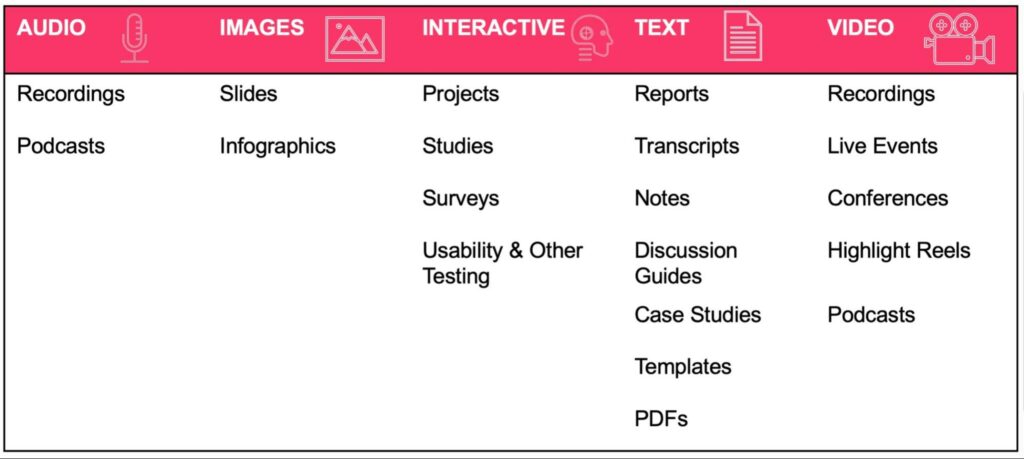
Two kinds of people will access the repository for the above data — producers (researchers) and consumers (stakeholders). It’s important to consider the needs and navigation of all parties while organizing your repository. There isn’t a one-size-fits-all approach, but the guidelines below will show you how to set up your research repository for success.
Roles & Regulations
First provide ownership — who will own and manage the repository? They act as gatekeepers for the rest of the organization. Define roles by establishing who will use and access the repository on a regular basis — decision-makers, product managers, designers, developers, power users such as researchers and view-only users. Establish ground rules on correct usage of the repository and document them. Adherence is key to maintaining an organized repository.
Information Architecture
Make sure you’ve conducted some research before you start thinking about organizing your data. It gives you an idea of how to structure your repository with appropriate taxonomy and metadata for your files. Taxonomy is nothing but a naming convention for your files and data. Stick to a consistent taxonomy and create a guide for new users to follow.
Tagging
Tag your data! We can’t stress that enough. Tagging converts unstructured data into smaller, semi-structured nuggets. This makes it more manageable, easier for you to digest and analyze the most granular items. When tagging, the simpler the better. Tagging is an ongoing process, one you’ll continue to refine as you go along. Don’t create new tags without normalizing the existing set. Click here to learn more about tagging your data using Marvin.
Maintenance Mode
Research repositories are living artifacts. Routinely update and maintain your repository to keep it organized. Devote time periodically for upkeep so that your repository remains easily accessible and searchable for users across your organization.
Head over here for more tips on how to structure and supercharge your research repository.

Relevant Elements in a Research Repository
Two kinds of elements live in a research repository — input and output.
Input consists of the information for planning and conducting research. Output is the by-product of research, in raw or polished form (reports etc). Information collected in user research can be disparate and difficult to organize.
Marvin to the rescue! Below, we created categories for elements that make up a research repository.
Infrastructure
Infrastructure consists of the background information needed to understand and use the repository. This helps guide researchers through the right processes when undertaking a research project. Infrastructure tends to be higher level documentation, not paying heed to everyday tasks and timelines.
Research infrastructure includes:
- Mission and vision. Outlines the goals of the research team. Any viewer will immediately understand the research team’s capabilities. This includes what the team does, why they do it and what can be requested of them.
- Methodology. Helps new researchers understand and how to carry out their work. Listing best practices and techniques ensures that they conduct research effectively. They understand how data is stored and collected, and why a particular method is used.
- Templates and Tools. Represents any artifacts that help in conducting and analyzing research data. Guides help users understand how to use the research repository software. These include surveys, interview scripts or discussion guides, protocols, reports and analysis, and participant consent forms for studies.
Research Planning
Winning teams use a Research Roadmap.
A research roadmap communicates a path to solving customer problems uncovered during research, and it should closely align with the product roadmap. It informs viewers how research goals tie into an organization’s strategic goals. Roadmaps outline an action plan to accomplish a company’s goals.
A detailed research roadmap must include:
- Projects. Communicates which projects are ongoing and in the pipeline. Allows viewers to prioritize based on importance. Project descriptions outline overall goals breaking these down into individual, everyday tasks.
- Schedules. Identifies what’s being examined and which research method is being used. Includes the date, time, location of a study, so that anyone can ask to join, or can view findings once it’s completed.
- Administrative Information. Contains details about company policies. It includes the funding details of research projects. Staffing and contributors for each project are established here. Includes the technology used and its interoperability with the company’s existing software stack. This maximizes the opportunity for exchange and reuse of information.
- Requests. Tracks research requests, which is especially important for larger organizations. This list allows people to see what’s already asked for, so they can make an informed decision to either leverage existing data or conduct a fresh research project.
Data & Insights
Over to the output of research. These nuggets of data inform user personas, user journey maps and research in general:
- Reports. Summarize methodology, findings and recommendations from a concluded research study.
- Insights. The detailed findings from a research study. Despite findings being included in reports, standalone insights help other researchers discover and use relevant nuggets in future projects.
- Transcriptions & Recordings. The bulk of a UX researcher’s time is spent in interviews or analyzing interviews. Making the interviews available and searchable helps others access these files in the future.
- Notes & Artifacts. Any notes or other items collected during the research process. They help enable an understanding of what researchers uncovered in the past. Newbies can incorporate this information when planning a new project.
Essential Research Repository Features
What functionality do you need in a research repository? How do you discern between the essentials, and ‘nice to haves’? Each company prioritizes certain requirements, however some functions are non-negotiable. To make life easier, we’ve come up with a handy acronym to recall the laundry list of features to look out for in a research repository tool:
‘SAAS ASPIRE’
Remember it this way: You have certain aspirations for your research repository software (as a service).
These are listed in no particular order of importance (other than giving you a catchy acronym).
Searchable
If you’ve ever been asked, “What do we know about X?” or “Have we got any data on X?”, this feature is for you. The ability to search and filter by keyword, or slice and dice your data enables quick discovery, consolidates insights and saves time. This increases the importance of the tagging exercise (above). A visually appealing and engaging search feature helps too. 😉
Accessible
Insights must be easily retrievable from the research repository. If I want to find out more about what customers said about Product A, I should be able to quickly search for “Product A” and “customer reviews”, for instance. Many platforms require people to have a separate login to access and simply view data or recordings. Tasked with creating a new account merely to view files, we’d rather not. A call for some simplicity, please.
Analyzable
Silly as this may sound, a repository that only houses customer insights is a bit dated. Ideally, you want a tool that enables you to import different forms of data for deeper analysis. Marvin and numerous other tools have the capacity to house qualitative and quantitative data. This avoids constantly jumping from one analysis tool to another. All your analysis in one place.

Shareable
Perhaps the most important feature — we introduced organizational silos and the data vacuum above. Disseminating insights elevates the user voice within an organization, bringing everyone on the same page. Sharing text is one thing, but sharing data in its original formats (table, above) is compelling. Moreover, at companies where research is a new practice, sharing communicates its value to non-researchers.
Artificial Intelligence (AI)
Bill Gates recently said that the advent of AI is as revolutionary as the graphical user interface, used to power mobile phones and computers. As we grapple with something that might eventually replace us, it becomes even more crucial to be able to leverage this key technology moving forward. AI has a host of applications within a UX research repository – it can help transcribe interview recordings, summarize lengthy transcripts and so much more. Your choice of repository wouldn’t be future proof and forward thinking if it didn’t have at least some AI capabilities.
Secure
Privacy is a fundamental human right. Corporations that have tracked and sold our data (a la Cambridge Analytica) are now being forced to double down, due to emerging data and privacy legislation. Information housed in a repository is highly sensitive and must be anonymized, protecting users. Look out for adherence to one (or more) set of standards from this list. Better safe than sorry.
Path Traceability
Connect insights to raw data. For the sake of our acronym, we cheated by adding ‘path’, but it only drives our point home further. Refer to the atomic research diagram above. If presented with purely insights, without how they were arrived at or deduced, decision makers are certain to question their validity and reliability. Linking raw data (any format from table, above) to an insight illustrates how we arrived at a certain conclusion and enables viewers to make their own deductions, given the information presented.
Integrations
Standing alone, repositories are of little use. Companies use a host of applications and platforms such as a CRM, project management and an ERP system. You might use Slack for messaging, Notion for documentation and Qualtrics for quantitative analysis. A key feature of a repository is the ability to talk to apps that you already use regularly. Marvin’s seamless integration with Zoom turns your research repository into a UX powerhouse. Explore all of Marvin’s integrations here.
Real-time Efficiency
Video is the preferred format of choice for qualitative data collection. It’s more interactive and can reveal non-verbal cues such as body language, genuineness (although some might have a solid poker face!), tone and expressions. Unlike most tools, Marvin transcribes interviews or calls as they unfold, freeing up your time to stay engaged and concentrate on these non-verbal cues. Use the time stamped LiveNotes feature to collaborate with your team and take important notes as you conduct interviews. This makes revisiting insights and tagging a breeze.
Ease-of-Use
Last, but certainly not least. A repository tool must have an intuitive design and user-friendly interface. Learning the ropes should be quick and easy. We pointed out earlier that a repository is not exclusively for researchers — product managers carry out their own research and key decision makers will likely rely on the tool for vital information. It must be straightforward for different personas to navigate through the various functions. We’ve spoken to umpteen users who were turned off other tools due to the complexity in navigation. Self-serve is the name of the game.
Ultimately, it’s up to you and internal stakeholders to gauge requirements and prioritize mandatory features for your repository. Every listed feature is important, with anything over and above it a ‘nice to have’. Admittedly, we didn’t leave much wiggle room.

How to Choose a Research Repository
Given the rather exhaustive feature checklist above, what are your choices when looking for a research repository? The way we look at it, you have two approaches to take when deciding on a repository tool:
- Homegrown – repurpose generic and free software. Why pay for something that you can get for free?
- Purpose-built – spring for a dedicated research repository tool. You get what you pay for.
Two very different schools of thought — let’s explore the first option in greater detail.
Homegrown Approach to Building a UX Repository
The following software can be fashioned into a makeshift UX research repository tool.
| Application | Type | Description |
| Airtable | Relational Database & Spreadsheet Interface | Simple, yet flexible interface with customizable fields and powerful filtering, sorting and linking capabilities. Houses reports and dashboards and 35 different integrations. Plenty of UX templates to get you started. |
| Atlassian | Project Management (Trello), Database (Jira) & Collaboration Tool (Confluence) | The amalgamation of several tools. Confluence serves as a repository for organizing internal knowledge in a company Wiki – with shared folders accessible organization-wide. Jira acts as a database tool. Weigh up the pros and cons of using Jira as a repository here. The sheer complexity may be overwhelming for first-time users. |
| Coda | All-in-One Collaboration & Productivity Platform | Similar to Notion (below), Coda is a flexible tool that allows users to create interactive, application-like documents with embedded elements such as tables, multimedia content and integrations to automate workflows. |
| GitHub | Software Development Project Platform (Web Hosted) | Primarily used as a version control platform for developers. GitHub can store research code, datasets and other digital assets as a repository. A recommended approach is to use separate folders for individual studies. Version control allows users to track changes. GitHub is open source, and therefore open to the public (truly democratizing research!) |
| Google Drive | Cloud Storage + Workspace (Docs, Sheets, Slides & Forms) | Good old Google. It’s tough to think of our lives without it. We use Drive and its productivity apps everyday for our personal and professional file management. Why not repurpose it into a research repository? |
| Miro | Collaborative Visual Whiteboard Platform | Miro published its own template with an accompanying guide on how to use their interface to create a research repository. Eden Lazaness, CX Director at Cambridge University Press, walks us through her Miro research repository here. Data isn’t housed within the platform, rather it’s linked to the board. Miro suggests having other templates (planning and synthesis) talk to this one above, increasing complexity. We’re not sure how this one would scale. |
| Notion | All-in-One Workspace Tool with Databases, Wikis & Project Management | Notion’s flexibility makes it a popular choice for numerous companies. A single yet multi-dimensional workspace, teams use Notion for a host of different functions – from company documentation, project tracking to data storage and retrieval. Check out this step-by-step guide on creating a user research repository in Notion. |
| Microsoft SharePoint | Web-based Collaboration Platform with Document Management | Usable as a repository for files, document libraries and information management. A similar approach to a GitHub repository (above), where each study has its own folder. More collaborative than GitHub for sharing knowledge and insights with peers via an organization’s intranet. Tight integration with Microsoft 365 apps. |
The Cons of Using a Generic Research Repository
You’re spoiled for choice with applications or tools when taking the homegrown approach. And it will save you money as you build a custom solution that’s tailored to your company’s needs. But reader beware, you may find some major drawbacks when repurposing a generic tool into your UX research repository:
- Feature Compromise: Does your repurposed software tick all the boxes from our SAAS ASPIRE list? Highly unlikely — you’re going to have to make certain concessions somewhere.
- Scalability: Bear in mind, ‘free’ tools wouldn’t exist if they didn’t have paid versions as well. The moment you scale or add complexity, the ‘free’ element of these applications disappears and you have to spend money to keep up with continually growing scale or features. That’s how they get you.
- Inefficiency: Time is money. The price you pay with heavy customization is time. It’s the fundamental economic concept of opportunity cost. What’s the cost of the time spent creating the research repository infrastructure vs. the time saved if you opt for a dedicated tool?
The homegrown makeshift route certainly gets the job done, but you must continually evaluate whether it’s to your satisfaction. With database tools like Notion, trying to make qualitative data fit into a quantitative format is a classic case of “square peg, round hole.”
The issue with a generic tool is that customization time and effort is high, and you don’t always end up with features that you really need. Don’t fall into the mousetrap of customizing an application consuming so much of your time, that it eventually reduces your overall productivity. We’re full of metaphors today — using freeware is like using anything but a hammer to get a nail in the wall. It might work, but not nearly as effectively as the real thing.
List of 8 UX Research Repository Tools
Organizations of all sizes turn to specialized research repository tools rather than building a resource from scratch. So how do you choose from the wide array of research repository tools that were listed above?
We’ve (obviously) got you covered. With research repositories aplenty, here’s a shortlist of the eight most popular choices:
1. Marvin
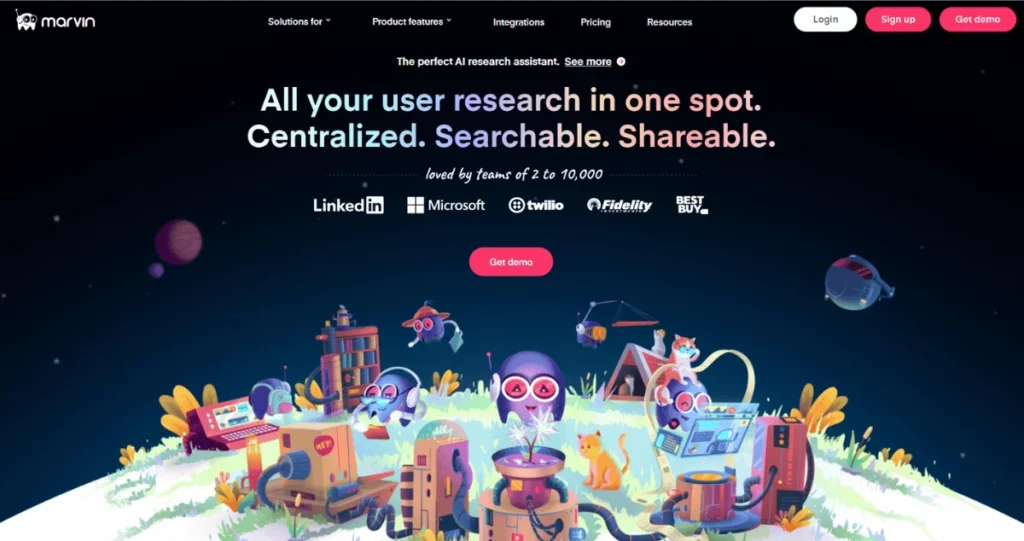
We saved the best for first.
Marvin is the only AI-powered research repository that automates your data analysis. Marvin houses ALL your research (both qualitative and quantitative) in one centralized location. It integrates seamlessly with applications that designers know and loved such as Figma, Miro, Confluence and Qualtrics.
Speaking of integrations, supercharge your research with Marvin’s videoconferencing workflow, which transcribes calls from Zoom, Microsoft Teams and Google Meet so you can focus on the person in front of you.
Marvin’s AI creates time-stamped notes from transcripts. Gloss over the highlights and delve deeper whenever you want. No more sifting through hours of interview footage.
The first-of-its kind survey engine lets you automatically analyze thousands of responses in minutes. This type of analysis used to take weeks of manual work.
Create stunning visualizations and string together interview clips to create powerful artifacts. Once stored, you can easily share these insights across the organization, helping you truly democratize research and make user-centric decisions.
Marvin’s Ask AI is a ChatGPT-esque search engine that enables you to search across all your customer knowledge. Make connections across projects to create a well-defined understanding of your users.
User information is sacred. Scrub out any faces and remove any personally identifiable information from videos and transcripts. Marvin is HIPAA, SOC2 and GDPR compliant. With Marvin, your user data is always protected.
The crème de la crème of research repositories. Save time, and dive deeper into your analysis with Marvin.
2. Aurelius

This research repository platform allows you to import various file formats such as audio, video, notes and spreadsheets. Leverage its Zapier integration to automate tasks. Global tagging allows you to analyze data across the repository and unearth insights.
When you add recommendations to key insights, Aurelius automatically builds an editable report for you. Share this report with any Aurelius user.
3. Chisel
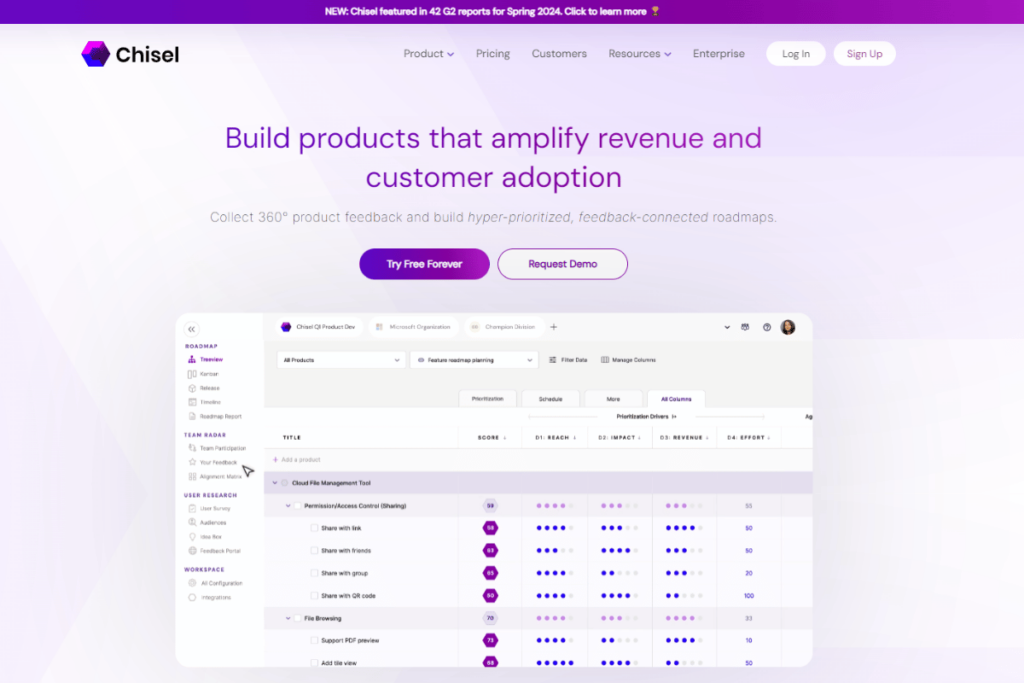
An AI-powered product management platform that also serves as a repository (They call it the ‘Idea Box’). Chisel’s AI features allow you to synthesize feedback in bulk for more efficient analysis.
Built-in features such as surveys and roadmaps help you get to the root of user problems. Target the right users by using their panel management software. Use different demographic filters to recruit the right participants.
4. Condens
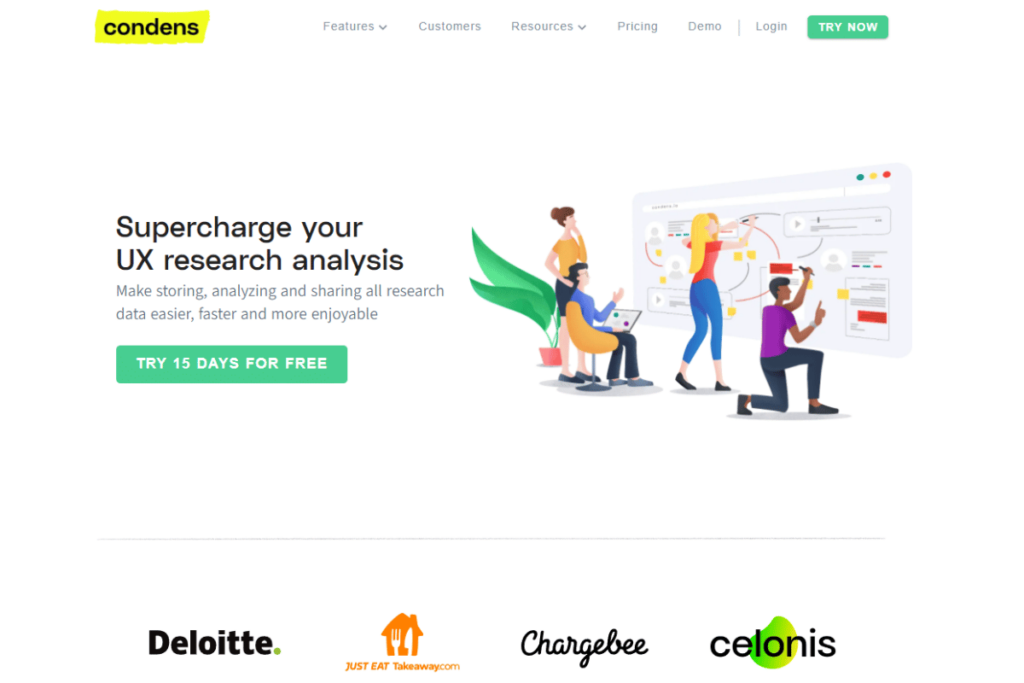
Condens helps you structure your user data before storing it for analysis. Condens has extensive features that help you recognize patterns, create artifacts and tag files efficiently.
Collaborate with peers on projects simultaneously and view modifications in real-time. Share insights with various stakeholders without sending across heavy files.
5. Dovetail
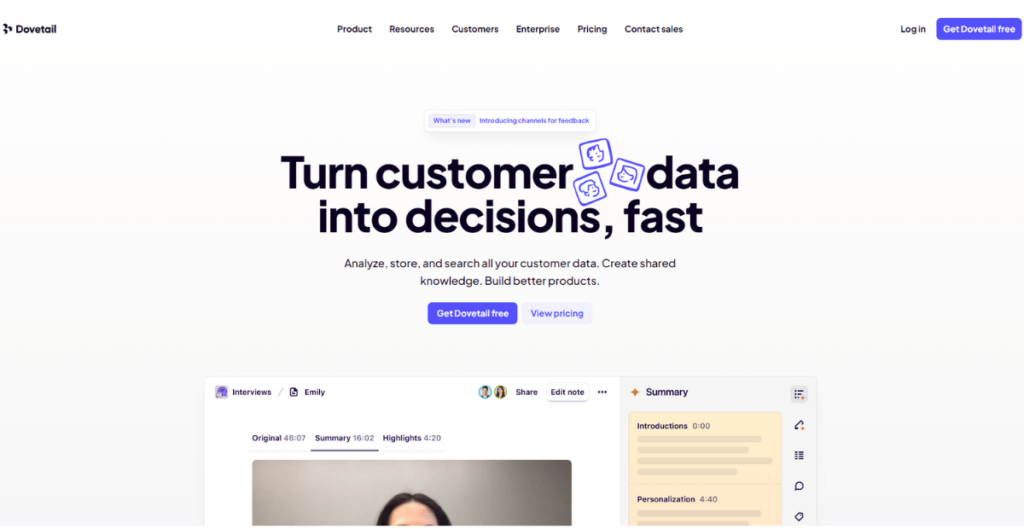
Dovetail is a customer insights hub that enables the collection, storage and analysis of research data. Capture user feedback from a variety of sources, then tag or label it to help catalog historical data.
Dovetail uses pattern recognition to identify problems before they get out of hand. It is designed to fit into a researcher or designer’s process after they have conducted a round of customer interviews or received feedback from users.
6. EnjoyHQ
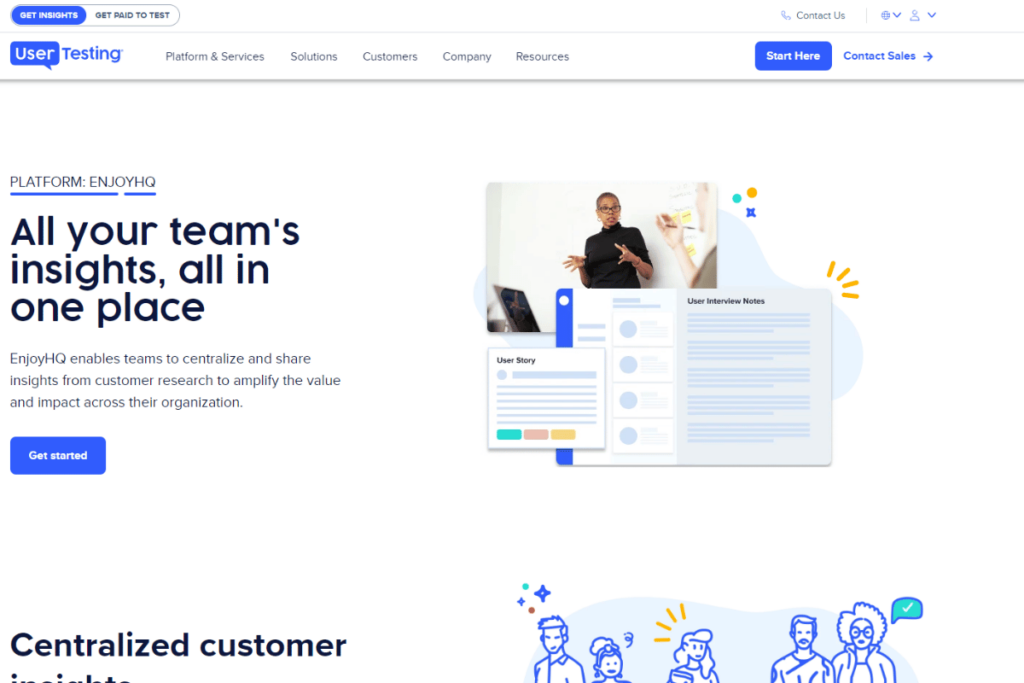
EnjoyHQ, now a part of UserTesting, is a centralized location for customer insights. It has unlimited data storage and transcription (when you opt in for a paid pan). It enables insight sharing across a company.
UserTesting and UserZoom share data with EnjoyHQ effortlessly. Other helpful features include feedback management, keyword tracking and qualitative comparative analysis.
7. Maze
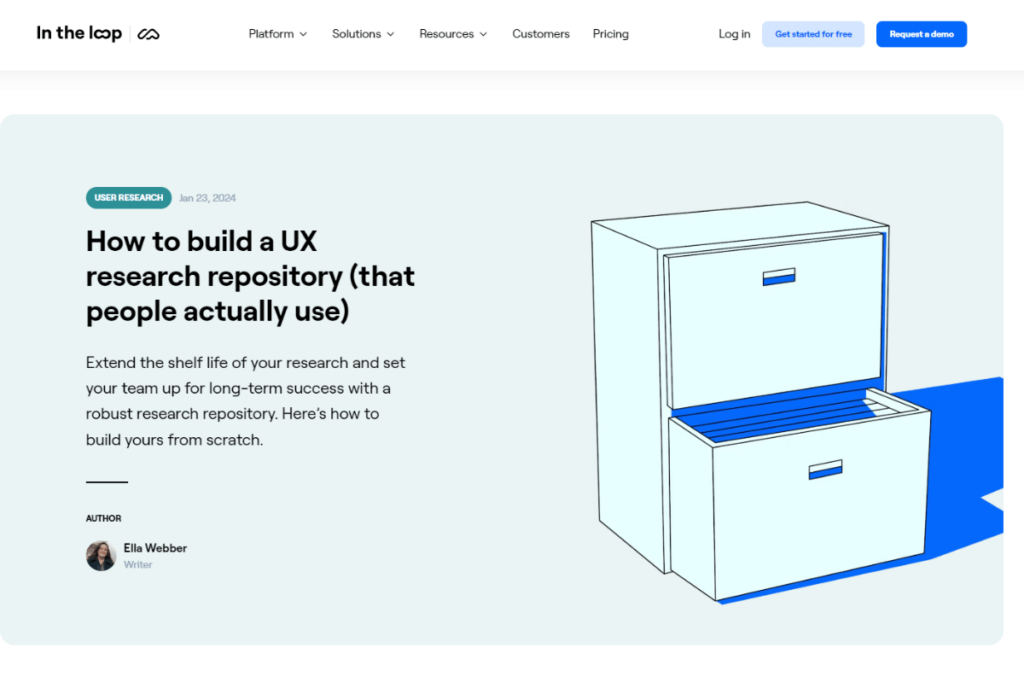
An all-in-one platform that includes user testing, panel and recruitment and of course, a repository. Maze has different product offerings for various industries, such as financial services, technology and enterprises.
Maze is a centralized research platform that helps you manage projects and workflows. Use templates from their gallery to build reports and deliverables that you can share with stakeholders. Automate report creation to visualize and identify patterns in data.
8. UserBit

A research repository tool for small businesses. UserBit uses AI automations to generate insights from tagged data. AI can also scan and tag your data automatically.
Create customized reports and post research findings on the Discovery portal so other stakeholders can view your work.
Benefits of a Modern Research Repository Tool
Above, we discussed the first of two different paths you can take when choosing your software. If you’re still reading, you likely chose not to explore the makeshift homegrown options. You clearly understand the value of supporting your research team with the best dedicated research repository tool.
Making research for everyone at your organization easier should be a priority. It will save you valuable time, resources and effort.
Speaking of, we’ll save you plenty of time, resources and effort right now with a short but comprehensive round-up:
- G2’s Top User Research Repositories (based on real user reviews)
- A Thorough Comparison of Every User Research Repository Tool (from 2023)
3 Research Repository Mistakes to Avoid
Why do research repositories fail? Several factors contribute to poor repository adoption.
Here are three of the biggest pitfalls to consider when implementing your research repository:
1. Buy-in & Onboarding Failure
Change is hard. People aren’t usually pumped to work with new tools. They need convincing. To get buy-in, explain to your stakeholders why a repository is needed and how it will benefit the whole business. Describe how centralized knowledge enhances collaboration between teams, reduces data silos and eradicates repetitive research. Once you choose a tool, getting people to use it requires another gargantuan effort. Spend time training people how to correctly use and contribute to the repository. (Far better than letting them run wild and having to clean up after them.
2. Wrong Tool Selection
Don’t bring a knife to a gunfight… or a supercomputer to a gunfight. The wrong tool fails to showcase the true value of research. It’s essential to keep your organization’s needs in mind as you choose the right one. Choose a tool that’s user-friendly and not complex, so people won’t get turned off using it. Future-proof your choice by addressing current needs and considering possible future ones. Leverage the fact that most tools have a free trial period. Try before you buy.
3. Ownership
If you’re expecting a UX research repository to solve all your problems, you’re in trouble. Role ambiguity leads to a lack of ownership on UX recommendations. Post-implementation, someone must take accountability since it requires ongoing efforts to maintain and improve the repository’s functionality. Roles must be clearly defined and guidelines followed — someone must constantly oversee these efforts.

Research Repositories: Getting Started
Not sure where to begin? Our panel of experts has their say on how to begin implementing and utilizing your research repository.
Unlock Internal Knowledge
Before jumping into using your repository, the first step is leveraging your existing knowledge base. Gina Rahn has seen numerous acquisitions take place during her time at LINQ, a K-12 educational software company. Whether new peers call it research or something else, they’re likely sitting on valuable information and knowledge. Gina tackled this problem head on — by treating coworkers as users, she was able to unearth utilizable insights from her internal research.
Read more about how Gina employs design thinking using Marvin.
In a similar vein, Lou Rosenfeld recommends conducting an ethnographic study of your organization. Not only does it get everyone up to speed with research efforts, it enables a company-wide understanding of what research brings to the table. All these valuable internal insights go into your research repository.
Broadcast Your Findings
“You have to be your own marketer — you’re doing the work, sharing it, broadcasting it up and down.” These words of wisdom are from Claire Rowell, Lattice’s first researcher.
Researchers like Claire often begin as one-person teams, so they must quickly perfect the art of communication. A research repository tool that facilitates easy sharing is a god-send for solitary researchers like Claire. The benefit of sharing insights across the organization is twofold — it elevates the voice of the user and simultaneously communicates the value of research. Claire shared more great advice for sole researchers beginning their journey.
Gina circulates a quarterly newsletter that informs everyone in the company of various research initiatives and developments. Colleagues tune in to video and sound bites from their users, fostering excitement around the product. This keeps the most important stakeholder at the forefront of everyone’s thoughts.
Orchestrate a Culture Shift
Easy enough, right? Sarcasm aside, to get buy-in from other teams and stakeholders it helps to give them access to the repository. Claire alludes to the fact that Marvin’s self-serve gets everyone energized about using an interesting repository tool.
Learn more about how Claire and her colleague Jared use Marvin to create a research-driven culture at Lattice.
At S&P Global, Pawana is clear that the research culture dynamic must be conducive to risk taking – ‘fail fast, fail early’. Inevitably, researchers will explore some questions that have a dead end, prompting no further action. The repository acts as a question bank for these studies from yesteryear, ensuring that no efforts are duplicated down the line.
Twilio research leaders involve as many peers as possible throughout the research process. The idea is to empower them to conduct some form of their own research, ensuring everyone is laser focused on solving the customer problem.
Putting It All into Perspective
Research repositories are vital to a company leveraging its internal and acquired knowledge over time. Unlike its quantitative counterpart, processing qualitative data is convoluted and cumbersome. Qualitative data tends to be text-heavy — there aren’t many visualizations such as graphs. Sifting through volumes of text must be effortless and painless.
In looking for a research repository tool, you must consider the needs of users outside of the research team when making your decision. It must be easy to use for product teams, designers, developers, engineers and decision makers alike within your organization. Users must be able to search and navigate through the repository with ease.
To optimize information architecture, you need to treat your repository implementation as a UX project in itself, a constantly evolving proposition that you continue to refine. In our opinion, using a makeshift tool is the equivalent of bringing a knife to a gunfight (we told you — we’ve got the metaphors down). You want a UX research repository that checks all the feature boxes (and there are plenty!)… one that’s built for scale and easy to use.


Frequently Asked Questions (FAQs)
Here are some frequently asked questions about research repository:
What is a Scientific Repository?
A scientific repository is a collection of data that is collected and stored with the intention of using the materials for future research. Scientific repositories house research and supporting documentation at various levels of granularity.
Researchers interact with a scientific repository in three ways:
- Primary collection or aggregation of information
- Storage, maintenance and distribution of repository information
- Secondary use or analysis of information
Scientific repositories allow research to be preserved over time so others can refer to and use existing work or findings.
What is the Role of Research Repositories in Research?
Research repositories act as a single source of truth for a company. This centralized knowledge bank houses all the data collected through research efforts.
Research repositories support the research function in three ways:
- Storage & Organization. Researchers can upload files in various formats from a variety of sources as they collect more data about their users. They must organize data before beginning their analysis.
- Analysis. Once stored, researchers can query the collected user data. Searchability is a function of a repository that enables them to interrogate the entire data library. They group items into themes and create tags to derive insights. Traceability (or path traceability) enables them to trace these insights back to raw data.
- Sharing. A repository makes data shareable across teams in an organization. Various stakeholders can benefit from insights derived from research. It enables others to validate research findings. This increases the transparency and trust in research work. Making data freely available enables others to build on a company’s foundational knowledge.
What is the Value of a Research Repository?
Research repositories help store and organize information obtained from UX research for analysis. A research repository provides value to an organization in several ways:
- Allows everyone in an org to find and track information easily.
- Surfaces insights from research that can drive key decisions about the business’s growth and direction moving forward.
- Makes research widely available and consumable across an organization. Stakeholders can access and analyze this data at any time.
- Offers a single source of truth. Avoids information becoming siloed within departments and people duplicating research efforts.
- Identifies potential areas of future research and lets others expand on existing research.
Overall, a research repository streamlines the work of the research team. Insights from a repository help inform decision-making. A centralized source of knowledge helps eradicate departmental silos and research repetition.
Well-defined research repositories increase collaboration across an organization and create awareness of the research function’s value.
Set up a free demo and see how to centralize your research with Marvin today.
Photo by Adrien Converse on Unsplash





